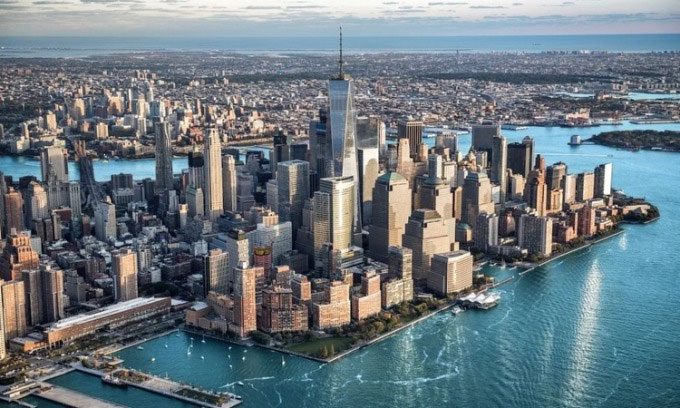Human activities and natural forces are causing many areas on the Earth’s surface to sink, threatening numerous densely populated cities.
New York City is slowly sinking into the Atlantic Ocean. Recent research indicates that the city is sinking at a rate of 0.1 – 0.2 cm per year. Combined with rising sea levels and increasingly intense storms, this could significantly heighten the risk of severe flooding. According to Tom Parsons, a researcher at the U.S. Geological Survey, while much of the city is built on artificial land, the heaviest skyscrapers are primarily constructed on solid bedrock. The sinking of the city is more related to geological factors than to construction practices. Sea levels are rising faster than the city’s sinking rate. However, many other cities around the world, from Jakarta, Indonesia, to New Orleans, are sinking much faster than sea levels are rising, according to National Geographic.

Skyscrapers in Manhattan, New York. (Photo: Ecowatch).
Sinking and Flooding
Each year, the global average sea level rises by about 0.3 cm. However, in some areas of Jakarta, the relative annual increase in sea levels can reach nearly 25 cm. This is not only due to high tides but also because the city is gradually sinking. “We need to consider both of these impacts,” said Pietro Teatini, a civil engineer at the University of Padova, Italy. “This is what people refer to as relative sea level rise, meaning the increase in sea level combined with land subsidence.”
Land subsidence occurs when human activities or natural forces cause many areas on the Earth’s surface to lower. This condition can lead to problems for both inland and coastal regions. Land subsidence has various causes (including human activities like groundwater extraction and building cities on soft sediments); it is not a direct result of climate change. Due to certain factors and specific geology, Jakarta is among the fastest-sinking cities in the world. With over 40% of the city currently below sea level and increasingly severe storms due to climate change, flooding in Jakarta has become so frequent and severe that the Indonesian government plans to relocate the capital to another island.
Water and Underground Resource Extraction
Cities create enormous subsidence problems when extracting from underground aquifers. According to Teatini, groundwater pumping is the primary cause of land subsidence worldwide. The rock and sediment in underground aquifers act like a sponge, containing many water-filled voids. When the water is extracted, these voids can collapse under the weight of the overlying soil. This is why groundwater pumping causes land to compress.
In Mexico City, scientists report that groundwater extraction causes the ground to sink by 36 cm each year. “The increasing population drives the demand for water. Therefore, they extract water from the aquifer, and the ground responds by sinking,” said geophysicist Shimon Wdowinski at Florida International University.
Over the past decade, the Mexican capital has sunk about 10 meters, bending buildings and damaging infrastructure. The primary cause is groundwater extraction, but the city’s unusual geography also contributes. Much of Mexico City is built on reclaimed lakes, where the old lakebed is very soft, saturated, and easily compacted. Voids in these rocks can be filled with hydrocarbons like oil or gas. Extracting these resources also causes subsidence, as seen in the Netherlands and around Ravenna, Italy.
Urban Development
In many parts of the Netherlands, the ground is sinking at a rate of 0.4 – 0.5 cm per year. Geologist Gilles Erkens at Utrecht University and the non-profit research institute Deltares states that the primary cause is human intervention in wetlands. Dredging wetlands for agricultural land can cause land to disappear. As wetlands dry out, oxygen from the air seeps into the soil, and bacteria begin to consume peat, transforming it into carbon dioxide for energy. This process causes the ground to shrink and weaken, leading to subsidence.
While this is primarily a rural issue, some Dutch cities like Gouda are built directly on peat land, according to Erkens. Since peat is easily compacted, it is highly susceptible to sinking under weight. Building heavy cities on soft sediments is not just an issue in peat areas. Many large cities from Shanghai, Jakarta, to Cairo are situated on river deltas, flat, fertile land at river mouths characterized by soft, wet soil like peat.
River delta silt compresses under its own weight over time, but frequent flooding can replenish it with new silt. Cities often construct levees to prevent flooding, but this also hinders new silt from reaching the delta. Building dams upstream also prevents silt transport, leading to subsidence and flooding.


















































